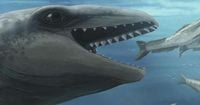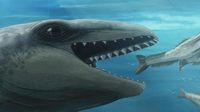On the rugged shores of Jan Juc Beach in Victoria, Australia, a discovery millions of years in the making has finally surfaced. Paleontologists have announced the unearthing of a new prehistoric whale species, Janjucetus dullardi, a find that’s already reshaping our understanding of whale evolution and the ancient oceans they once ruled. The official announcement came on August 15, 2025, but the story behind this fossil stretches back some 25 million years, to the Oligocene Epoch—a time when the world’s seas teemed with creatures both familiar and utterly alien.
The fossil, a remarkably preserved juvenile specimen, was found by Ross Dullard, an amateur fossil hunter whose name the species now bears. Dullard’s chance encounter with the ancient bones happened during a low-tide stroll along Jan Juc Beach, a spot already known among enthusiasts for its paleontological promise. At first, Dullard spotted what he thought might be just another tooth. But as he examined the find, something felt different. "I thought, geez, we’ve got something special here," Dullard recalled to Museums Victoria, his excitement palpable even now. He quickly snapped photos and sent them to the experts. The response was swift: this was no ordinary fossil.
Erich Fitzgerald, senior curator of vertebrate paleontology at Museums Victoria Research Institute and a lead author of the study published in the Zoological Journal of the Linnean Society, immediately recognized the fossil’s significance. Not only was it exceptionally well-preserved, but it also belonged to a group so rare that only three other species had ever been identified: the mammalodontids. These ancient whales, which flourished during the Oligocene Epoch (roughly 34 to 23 million years ago), are considered a crucial link in the evolutionary chain that led to modern baleen whales.
Janjucetus dullardi, as described in the study, was a peculiar animal by any measure. Picture a whale with bulging, oversized eyes—"resembling tennis balls," as the researchers put it—perched atop a head with a shark-like snout bristling with menacing teeth. This was no gentle giant of the deep. Instead, Janjucetus was a small, agile predator, measuring about three meters (ten feet) in length—small enough, in fact, to fit on a single bed. Its anatomy suggests a lifestyle far removed from today’s filter-feeding whales; this was a hunter, stalking the ancient seas with sharp senses and a jaw built for snapping up prey.
Fitzgerald summed up the animal’s appearance with a wry smile: "It was, let’s say, deceptively cute." The phrase belies the creature’s formidable predatory adaptations, which stand in stark contrast to the image of modern whales as gentle, baleen-filtering giants.
What makes Janjucetus dullardi even more remarkable is its place in the evolutionary tree. The mammalodontids, to which it belongs, represent a branch of early whales that would eventually give rise to the baleen whales—today’s humpbacks, blues, and their kin. But Janjucetus and its relatives were still a long way from the streamlined behemoths we know now. Their bodies likely bore vestiges of their land-dwelling ancestors: rudimentary legs, described as little more than stumps, protruded from their sides. These limbs, useless for walking, hint at a time when whales were still transitioning from land to sea, their bodies caught between two worlds.
The rarity of such fossils cannot be overstated. As Fitzgerald explained, "It’s only the chosen few, the vast minority of all whales that have ever lived and died in the oceans over millions of years, that actually get preserved as fossils." The harsh, dynamic conditions of the ocean floor rarely allow for the kind of preservation seen in Janjucetus dullardi. Each new specimen is a window into a lost world, offering clues not just about the animal itself, but about the ecosystems and climates in which it lived.
The discovery has been a personal triumph for Dullard, whose persistence and passion for fossil hunting have finally paid off in spectacular fashion. "It’s literally been the greatest 24 hours of my life," he said, reflecting on the whirlwind of excitement following the announcement. To celebrate, Dullard plans a fossil-themed party, complete with games and treats shaped like whales—a fitting tribute to a journey that spanned six years and countless hours combing the beach.
Beyond the thrill of discovery, Janjucetus dullardi is already changing the way scientists think about whale evolution. Its unique combination of features—predatory teeth, bulging eyes, a compact body—challenges previous assumptions about how and when modern whale traits emerged. The fossil provides a snapshot of a pivotal moment in cetacean history, when ancient whales were experimenting with new ways to survive and thrive in their aquatic environment.
But the find also raises tantalizing questions. What did these early whales eat? How did they hunt? And how did their bodies adapt to the challenges of life in the open ocean? While Janjucetus offers some answers, much remains unknown. The incomplete nature of the fossil record means that many mysteries endure, waiting for the next lucky discovery to bring them into the light.
The implications of this research extend far beyond academic curiosity. By understanding how ancient whales like Janjucetus dullardi adapted to changing environments, scientists hope to glean insights into how today’s marine life might respond to the rapid changes brought on by climate change. The evolutionary innovations that allowed whales to conquer the seas millions of years ago could hold lessons for the survival of modern species facing unprecedented environmental pressures.
As paleontologists continue to explore the ancient coastlines of Australia and beyond, each new discovery brings us a step closer to unraveling the complex tapestry of life on Earth. The story of Janjucetus dullardi is a reminder that the past is never truly lost—it’s just waiting to be found, sometimes in the most unexpected places. And who knows? The next chapter in the saga of whale evolution may be buried beneath the very sands we walk on today, waiting for another curious mind to uncover its secrets.
For now, the world celebrates Janjucetus dullardi, a small, sharp-toothed predator whose ancient bones have given us a giant leap forward in understanding the origins of the whales that still roam our oceans. The discovery stands as a testament to the power of curiosity, persistence, and the enduring mysteries of the deep.





